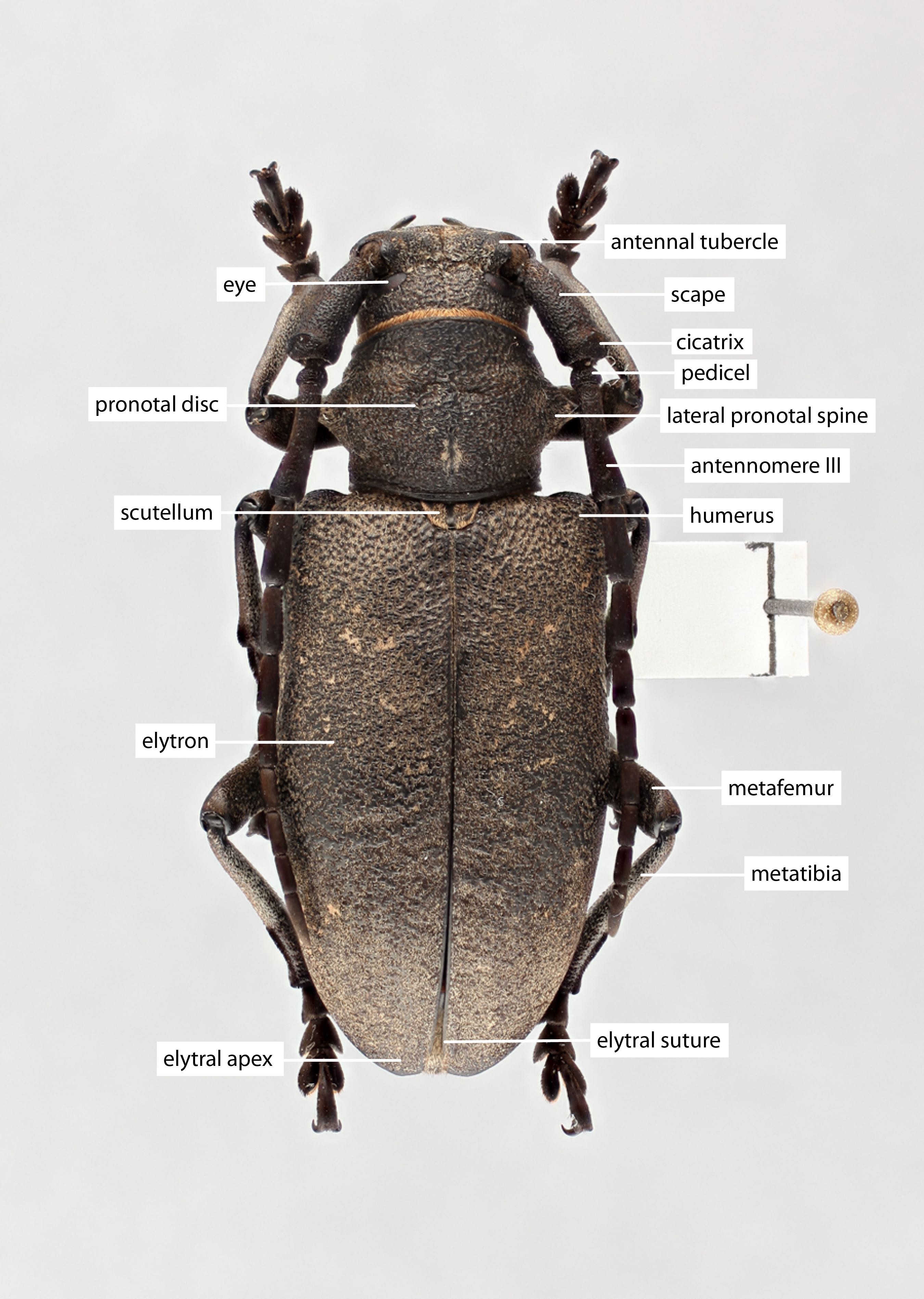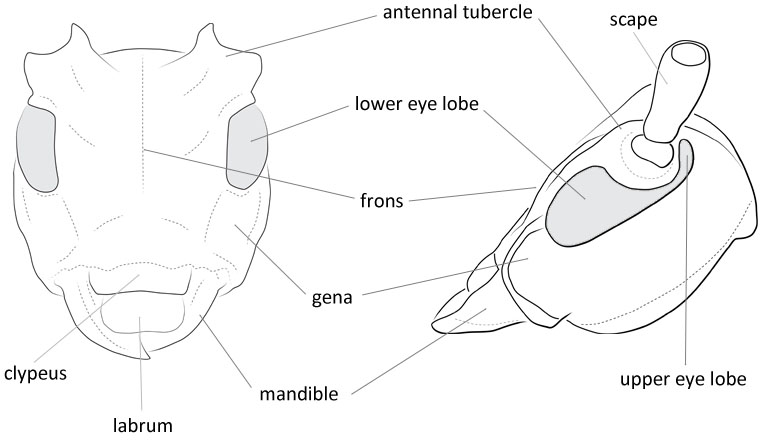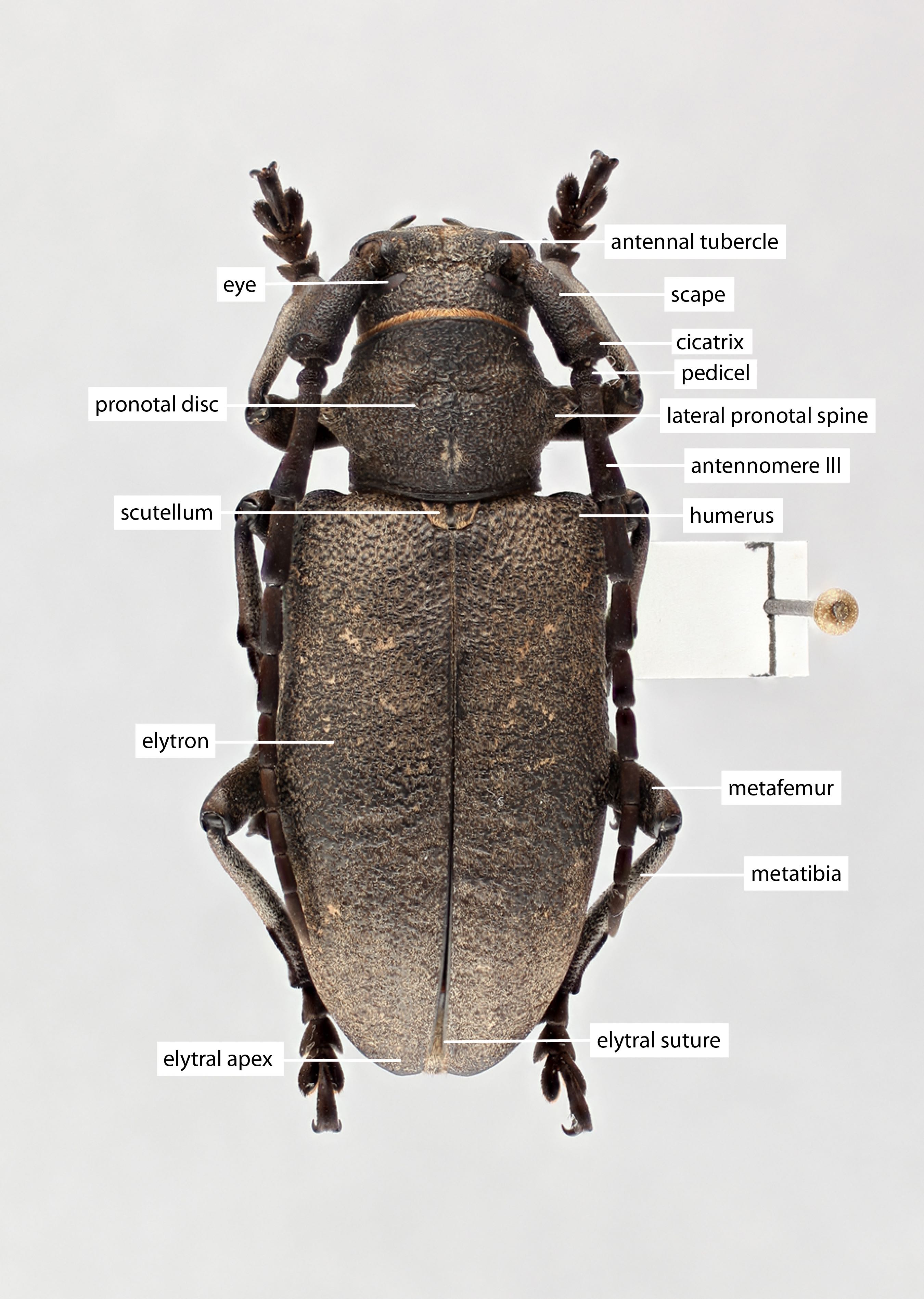Monohammus nitens Bates, 1884: 238
Length: 23–29 mm.
Elytral length:width ratio: length > 2x width.
Face: shape wide rectangle; genagena:
the part of the cranium on each side below the eye length longer than lower eye lobeeye lobe:
length longer than lower eye lobeeye lobe:
used to refer to the upper or lower portion when the eye is emarginate or separated or subequal to lower eye lobeeye lobe:
or subequal to lower eye lobeeye lobe:
used to refer to the upper or lower portion when the eye is emarginate or separated .
.
Pronotum:pronotum:
the upper and dorsal part of the prothorax
dense setaeseta:
a sclerotized hair-like projection of the cuticle
on dorsum of lateral spines present; maculaemacula:
a spot or mark
on pronotal disk: 2–4 dots present; posteromedial tubercletubercle:
a small knoblike or rounded protuberance
absent; lateral erect setaeseta:
a sclerotized hair-like projection of the cuticle
: present posterior and anterior to spinespine:
a protuberance with an acute (sharp) distal end
.
Scutellum:scutellum:
a small sclerite located directly posterior to the pronotum, bordered laterally by the elytra pubescence broken at least partially along midline.
pubescence broken at least partially along midline.
Elytra:elytron:
the leathery forewing of beetles, serving as a covering for the hind wings, commonly meeting opposite elytron in a straight line down the middle of the dorsum in repose
elytral integument color black; elytral maculaemacula:
a spot or mark
: sparse ash-like pubescence; elytral sutural apexapex:
end of any structure distad to the base
rounded; elevation in basal third followed by impression present; basal granulation nearly absent; middle to apical punctationpunctation:
pits or depression of variable size in cuticle
nearly impunctate.
Antennal length (female): 2–3.5 segments beyond elytral apexapex:
end of any structure distad to the base
.
Aedeagus:aedeagus:
in male beetles, the penis
paramereparamere:
A pair of finger-like structures that are located where the male genitalia exits the abdomen.
mediobasal tooth present; apical tip (ventral view) truncatetruncate:
cut off squarely at the tip
or weakly bifidbifid:
cleft or divided into two parts; forked
; scleritesclerite:
any hardened plate of the body wall bounded by membrane or sutures; sometimes found floating in the internal sac of male genitalia
in internal sac: contains a scleritesclerite:
any hardened plate of the body wall bounded by membrane or sutures; sometimes found floating in the internal sac of male genitalia
in internal sac.
Characterized by convex lustrous elytraelytron:
the leathery forewing of beetles, serving as a covering for the hind wings, commonly meeting opposite elytron in a straight line down the middle of the dorsum in repose
, yellow spotlet on sinciput, and other distinguishing characters. Head with compact uneven (on occiputocciput:
dorsal part of the head between the occipital sulcus and the postoccipital sulcus
, antennal tubercles, and along frontal lobes with bold, in middle of fronsfrons:
the upper anterior portion of the head capsule, usually a distinct sclerite between the epicranium and clypeus with very minute) punctationpunctation:
with very minute) punctationpunctation:
pits or depression of variable size in cuticle
and adherent gray or yellowish hairs, with narrow median longitudinal groove and produced antennal tubercles. Eyes sharply faceted, deeply incised. Antennaeantenna:
in larval and adult insects, paired segmented appendages, borne one on each side of the head, functioning as sense organs and bearing a large number of sensilla
2.0 (male) or 1.2 (female) times longer than body, extending beyond apexapex:
end of any structure distad to the base
of elytraelytron:
the leathery forewing of beetles, serving as a covering for the hind wings, commonly meeting opposite elytron in a straight line down the middle of the dorsum in repose
by 6th (male) or 10th (female) segment, with dense granular (male) or minute simple (female) punctationpunctation:
pits or depression of variable size in cuticle
. Pronotumpronotum:
the upper and dorsal part of the prothorax
not longer (male) or shorter (female) than basal width, in anterior third with broad, at posterior margin with narrow flange, laterally with large, conically extended tubercletubercle:
a small knoblike or rounded protuberance
, convex, with bold uneven punctationpunctation:
pits or depression of variable size in cuticle
, on flanges with transversetransverse:
broader than long
striae, with somewhat rusty or grayish hairs forming one large spot on each flange. At basebase:
the part of any appendage or structure that is nearest the body
of lateral tubercles two transversely set spotlets occur on anterior flange. Pronotal shield posteriorly broadly rounded, with dense adherent rusty or gray hairs, medially with glabrousglabrous:
smooth, devoid of pubescence; devoid of any sculpturing
longitudinal band. Elytraelytron:
the leathery forewing of beetles, serving as a covering for the hind wings, commonly meeting opposite elytron in a straight line down the middle of the dorsum in repose
parallel-sided, in anterior third with distinct or faint semicircular depression leaning toward inner side of humerihumerus:
shoulder; the basal exterior angle of the elytra by its ends, beyond humerihumerus:
by its ends, beyond humerihumerus:
shoulder; the basal exterior angle of the elytra slightly compressed, apically individually (female) or jointly (male) rounded, basally with coarse, in remaining part with barely perceptible, evanescent punctationpunctation:
slightly compressed, apically individually (female) or jointly (male) rounded, basally with coarse, in remaining part with barely perceptible, evanescent punctationpunctation:
pits or depression of variable size in cuticle
, highly lustrous surface, with sparse semi adherent rusty-brown and dense compact adherent yellow or white hairs forming spots of different sizes, imparting a mottled appearance. Forelegs in males slightly longer than midlegs, midtibiae on outer side with barely perceptible distaldistal:
near or toward the free end of any appendage; that part of a segment farthest from the body
notch bearing short brownish bristles forming brush. Abdominal sternite V in female with gentle apical notch, laterally bearing long dense black hairs forming two characteristic clusters at end. Sternite V in male apically obtuse, with short rusty hairs. Body, antennaeantenna:
in larval and adult insects, paired segmented appendages, borne one on each side of the head, functioning as sense organs and bearing a large number of sensilla
, and legs black, sinciput with somewhat rusty spotlet. Elytraelytron:
the leathery forewing of beetles, serving as a covering for the hind wings, commonly meeting opposite elytron in a straight line down the middle of the dorsum in repose
black, lustrous. Body length 23–29 mm. (Cherepanov 1990Cherepanov 1990:
Cherepanov AI. 1990. Cerambycidae of Northern Asia, Vol. 3. Lamiinae, Part I. Oxonian Press, New Delhi 4: i–xiii + 1–300, 120 figs.)
N/A
M. sartor sartor, M. scutellatus
The elytral sculpture in M. sartor is punctatepunctate:
set with fine, impressed points or punctures appearing as pin-pricks
and more matte than the shining and impunctate M. nitens. New World species do not have a distinct raised area followed by an impression at the basebase:
the part of any appendage or structure that is nearest the body
of the elytraelytron:
the leathery forewing of beetles, serving as a covering for the hind wings, commonly meeting opposite elytron in a straight line down the middle of the dorsum in repose
or a scleritesclerite:
any hardened plate of the body wall bounded by membrane or sutures; sometimes found floating in the internal sac of male genitalia
in the male genitalia.
Japan, Sakhalin; reports from Korea likely transported
Abies, Larix, Picea, Pinus (Titan DatabaseTitan Database:
Tavakilian GL and Chevillotte H. 2022. Titan: base de données internationales sur les Cerambycidae ou Longicornes. Version 3.0. Available from: http://titan.gbif.fr/ last accessed September 2022)
M. nitens seems to have a close affinity to M. sartor and may have separated during Pliocene glacial cycles with Japan isolated from the mainland.
Monohammus griseonotatus Pic, 1921: 6